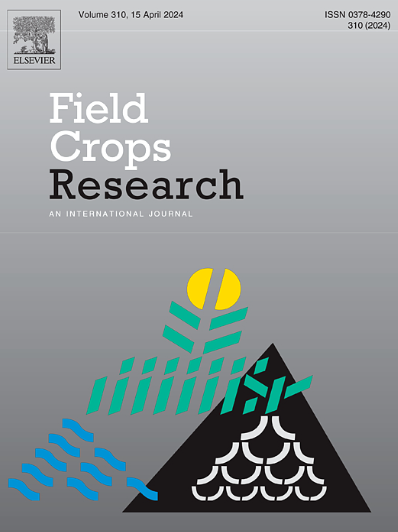在半干旱地区,大豆-玉米间作与水分管理相结合可提高叶片性状,从而获得产量效益
IF 5.6
1区 农林科学
Q1 AGRONOMY
引用次数: 0
摘要
背景间作可以提高土地利用效率,为实现粮食安全和可持续农业提供了很好的途径。然而,在半干旱地区,水分管理对间作生产力的影响仍有待进一步研究,尤其是大豆-玉米间作中与作物叶片光合参数相关的产量优势背后的机制仍不清楚。方法 在中国半干旱地区内蒙古包头市进行了为期两年的田间试验,采用双因素随机区组设计。研究比较了在两种水分管理策略(因子 B)下大豆-玉米交替间作(RI)和条播大豆-玉米间作(SI)与相应的单作(因子 A),并分析了间作中作物叶片功能性状介导的生物量积累和产量优势。结果结果表明,RI 的 LER 在 1.07 至 1.17 之间,大豆和玉米的平均部分土地当量比(pLER)分别为 0.20 和 0.92。SI 的 LER 为 1.13 至 1.35,大豆和玉米的 pLER 分别为 0.38 和 0.86。大豆-玉米间作的平均净效应为 5.41 兆克/公顷。虽然大豆-玉米间作的净效应与水分管理无关,但与减少灌溉的脊-犁处理(WM0)相比,不覆盖塑料薄膜的全灌溉处理(WM1)提高了间作系统的净效应。间作通过增加叶面积指数而不是改善叶片光合参数,提高了生物量积累和谷物产量。结论在半干旱地区,大豆-玉米间作可以实现产量优势的权衡。意义 本研究揭示了半干旱地区大豆玉米间作的产量优势机制,并提出了合理的水分管理策略。特别是在带状间作中,应考虑优化水分管理策略,以进一步提高土地生产力。本文章由计算机程序翻译,如有差异,请以英文原文为准。
Soybean-maize intercropping combined with water management enhances leaf traits to obtain yield benefits in semi-arid regions
Context
Intercropping can enhance land use efficiency and offer promising ways for achieving food security and sustainable agriculture. However, the impact of water management on intercropping productivity still needs to be further studied in semi-arid areas, particularly the mechanisms behind the yield advantages related to crop leaf photosynthetic parameters in soybean-maize intercropping are still unclear.
Objective
The current study aimed to assess the effects of cropping systems and water management on crop biomass accumulation, photosynthesis, grain yield, land equivalent ratio (LER), and economic benefits of soybean-maize intercropping systems in semi-arid regions.
Methods
A two-year field experiment using a two-factor randomized block design was conducted in Baotou, Inner Mongolia, a semi-arid region of China. The study compared alternate soybean-maize intercropping (RI) and strip soybean-maize intercropping (SI) with the corresponding sole cropping (Factor A) under two water management strategies (Factor B), and analysed crop leaf functional traits mediated biomass accumulation and yield advantages in intercropping.
Results
Results showed that the LER ranged from 1.07 to 1.17 for RI with average partial land equivalent ratio (pLER) at 0.20 and 0.92 for soybean and maize. The LER of SI ranged from 1.13 to 1.35 and the pLER of soybean and maize were 0.38 and 0.86. The average net effect of soybean-maize intercropping was 5.41 Mg ha–1. Although the LER was independent of water management, full irrigation without plastic film mulch treatment (WM1) boosted the net effect of intercropping systems compared with the reduced irrigated ridge-furrow treatment (WM0). Intercropping enhanced biomass accumulation and grain yield by increasing the leaf area index rather than improving leaf photosynthetic parameters. Additionally, WM1 improved crop leaf functional traits and enhanced biomass accumulation contributing to higher yield advantages and economic benefit compared with WM0.
Conclusions
In semi-arid regions, soybean-maize intercropping can achieve trade-off situations of yield advantages. Especially, strip soybean-maize intercropping with WM1 has obtained the highest yield advantage and economic benefit by enhancing the functional traits of crop leaves.
Implications
The current study deciphered the mechanism of yield advantages for soybean-maize intercropping in semi-arid regions, and also proposed reasonable water management strategies. Especially in the strip intercropping, the optimized water management strategies should be considered to further increase land productivity.
求助全文
通过发布文献求助,成功后即可免费获取论文全文。
去求助
来源期刊

Field Crops Research
农林科学-农艺学
CiteScore
9.60
自引率
12.10%
发文量
307
审稿时长
46 days
期刊介绍:
Field Crops Research is an international journal publishing scientific articles on:
√ experimental and modelling research at field, farm and landscape levels
on temperate and tropical crops and cropping systems,
with a focus on crop ecology and physiology, agronomy, and plant genetics and breeding.
 求助内容:
求助内容: 应助结果提醒方式:
应助结果提醒方式:


